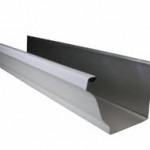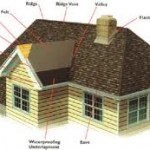
Gutter Repair and Maintenance
Gutters are an essential part of a home’s exterior. They handle an enormous amount of water and deposit it where you want it to go — preferably away from your home’s foundation. When gutters fail, a wet basement and other problems can be the result. This roofing guide looks at gutter repairs — identifying and fixing the most common problems with gutters.
Leaking Gutter Seams
Gutter leaks are common with gutters that have seams. Today’s extruded gutters are seamless, but many homes still have gutters with seams where two pieces have been joined together. The best time to find out if gutter seams are leaking is when its not raining. When gutters are dry, turn on the garden hose and let it run into the gutter at the location furthest from the downspout. Within 3-5 minutes you will see water leaking if there is a problem. Mark the seams that are leaking and turn off the hose.
Let the water drain from the gutters and allow the gutter to dry completely. Use a coarse brush to clean in the inside and outside of the seams, and then wipe them with a cloth to remove dust and grit. Use silicone rubber caulk to seal the seams on both the inside and the outside of the gutter. Don’t put on an excessive amount, but do “tool” the caulk to press it into the seams. Avoid using your finger because seams can be sharp. A putty knife will work well.
Small Holes
Small holes in aluminum gutters can be patched with roofing cement and a putty knife. Make sure the area around the hole is very clean and dry. Spread on enough cement to fill/cover the hole and and about an inch in each direction. On cool days, keep the cement inside your home until you are ready to use it. Warm cement is easier to work with. If the cement sags in the hole, you’ve got a large hole that needs to be patched.
Large Holes
Use a piece of sheet metal to cover the hole, and use roofing cement to hold the patch in place. Cover the edges of the patch with cement to prevent water from working its way under it. Again, make sure the entire area is clean and dry so you will get the adhesion you need.
Sagging Gutters
With time, gutters may sag and cause low spots that hold water. The way to fix sagging gutters is to add gutter hangers. Attach one at the sagging spot and raise it up until it is inline with the rest of the gutter. Don’t raise it too high or you’ll create a new “low spot” that will hold water.
Overflowing Gutters
The primary cause of overflowing gutters is a blockage caused by leaves, debris, a tennis ball, etc. Clean out the gutters at least a couple of times a year, or as needed, especially in the fall when falling leaves and falling rain are a common combination in many parts of the country.
A second cause of overflowing gutters is gutters that simply aren’t big enough or that are asked to carry too much water. You may need to replace gutters with those that can carry a larger volume of water. Another option is to section the gutter and add a downspout in the middle, effectively dividing the amount of water it is required to carry.
Leaking Downspouts
Leaking downspouts are a serious problem because they handle a lot of water and leaks can lead to water finding its way into your basement or crawl space. While repairing leaks in downspout seams may work, it is probably a better idea to replace the downspout rather than risk serious damage to your home’s foundation.
Short Downspout Extenders
If your downspout dumps water onto a driveway or patio that is sloped away from the house, a short horizontal elbow or extension is fine. But if the downspout dumps water onto grass, you need to make sure it empties at least 4 feet away from the foundation, and 6-8 feet is better, especially if you have soil containing clay. Accomplish this by adding downspout extenders. They are inexpensive and readily available at home improvement stores. Solid drain tile will work just as well as long as it can be secured to the downspout effectively.
Finally, It is important to make gutter repairs on a regular basis so that you can control the flow of water away from your home’s foundation. Check them twice a year at least and clean them often. With maintenance and cleaning they should do their job and help keep your basement dry.
Gutter Repairs Articles and Guides

Do Seamless Guter Prices Drop when Having a New Roof Installed?
When it’s time for a new roof, does it also make sense to have the gutters and downspouts replaced? You might find that it is cost-effective, and there... more

Most Common Roof Repair Costs and How Long they Take to Complete
A roof needs regular maintenance like any other parts of your home including the HVAC system and the yard. Here’s an overview of the most common roofing... more

Inspecting Your Roof After a Hurricane, Where to Look for Roofing Damages
Inspecting your roof after a hurricane is vitally important. You want to find and fix any damage as quickly as possible so your roof isn’t vulnerable... more

What Can a Homeowner Do to Extend Roof Life?
Perhaps you’ve just had a new roof installed and the price of it has motivated you to find out how to make it last. There are steps that handy... more

Knowing When to Call in a Roofing Contractor
Many homeowners have the skills and tools to work on their own homes, doing maintenance, repairs and renovations. There are times, however, when calling... more
